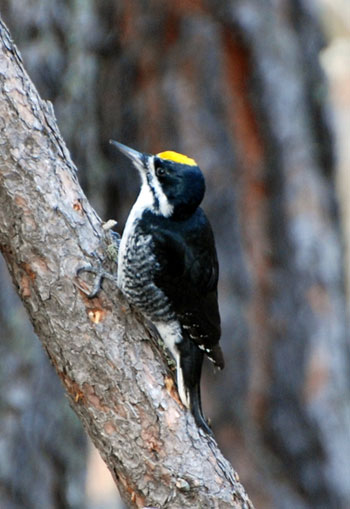By Michelle Werts

Wildfires are one of the most prolific forces affecting our nation’s forests. They are often intense and unpredictable — and are only likely to become more so in the coming decades thanks to climate change. They threaten homes and communities, which is why American Forests supports projects like the U.S. Forest Service’s Collaborative Forest Landscape Restoration program, designed to reduce wildfire risk in local communities. They can be scary things, but for many species, they aren’t scary at all. Instead, they are essential for life.
The black-backed woodpecker is one such species because it likes beetles, and do you know what beetles like? Blackened forests. Why? Because fire-damaged trees are easier for wood boring, of course. Unfortunately for the black-backed woodpecker, though, in 1936, the U.S. embarked on a fire suppression policy that would last for decades. Low-intensity burns were squelched before they could get started and the woodpecker’s preferred fire-burned habitat began to disappear — and so did the woodpecker. Compounding matters were salvage efforts in post-fire landscapes, where damaged wood was removed for logging purposes instead of being allowed to regenerate naturally, which again, removed habitat and food source for burn-loving species that actually moves its habitat to coincide with burn areas.
Last spring, conservation groups petitioned to have the black-backed woodpecker added to the Endangered Species List, and American Forests joined the effort through a letter in our Action Center, which allowed our members to speak out and encourage management of post-fire landscapes that accounts for species that need burned forests to survive. Earlier this month, it was revealed that those voices were heard, as the U.S. Fish and Wildlife Service announced that it would consider the species for federal protection and was opening a 60-day information-gathering and comment period.

But what about other fire-loving species? American Forests has its conservation sights set on protecting and restoring another: whitebark pine. Growing in the high-elevation forests of the Mountain West, whitebark pine is considered a keystone and foundation species. It earns this status by providing food for a variety of wildlife and serving as shelter for hundreds of plant and animals species, protecting them from harsh weather on the mountaintops. But while it’s looking out for others, who’s looking out for it?
Decades of fire suppression mean that the whitebark’s forests are more densely populated than the species would like. Being a pioneer species (or one of the first to populate an ecosystem), it doesn’t do well with competition, and its seeds struggle to survive. Plus, a dense canopy results in less sunshine, and the whitebark loves to — no, needs to — soak up the rays to flourish. Low-intensity fires would help clear some of the competition and open up the forest canopy to some sunlight for the whitebark, which needs all the help it can get since it’s also facing threats from an unprecedented outbreak of mountain pine beetles and white pine blister rust.

The American Forests Endangered Western Forests initiative is providing some of that help. We’re creating healthy planting sites for whitebark pine, planting disease-resistant seedlings, reducing the amount of competing species to help with natural regeneration and so much more.
You know who else might help the whitebark? The black-backed woodpecker. Remember? It finds beetles tasty, including mountain pine beetles. So if we help one, we might help the other. Welcome to the glorious circle of life.